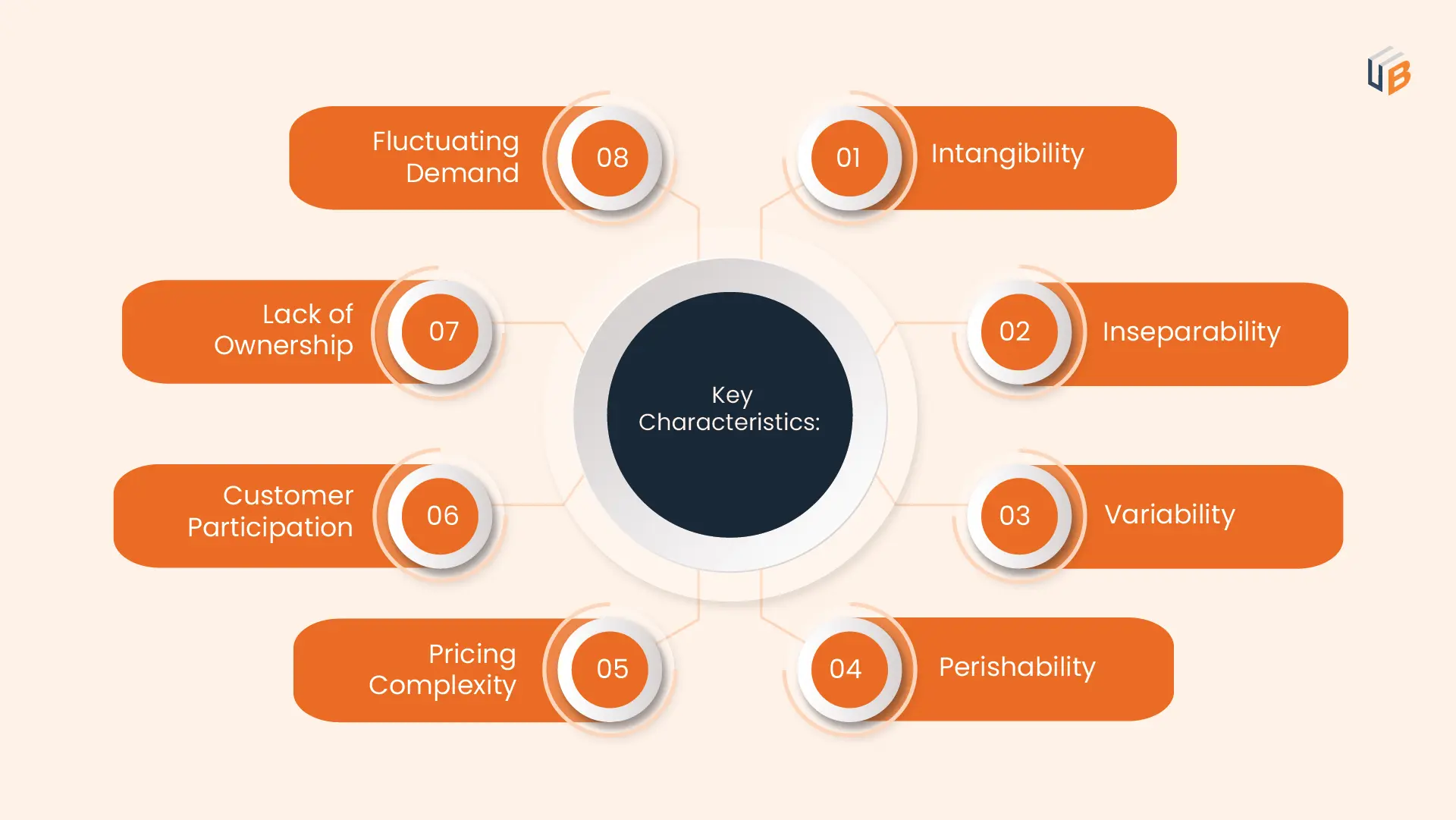
Service marketing is different from product marketing.
When you’re selling a product, you’re dealing with something tangible that people can see, touch, and own. This is where product marketing comes in.
On the other hand, a service is intangible. It focuses on factors like expertise, customer interactions, and quality. This falls under service marketing.
Service marketing is both rewarding and challenging. It demands unique strategies to effectively convey value to customers.
In this post, we’ll discuss the key characteristics of service marketing, its significance, and the various strategies to market your services successfully.
What is Service Marketing?
Service marketing is planning, pricing, promoting, and distributing a service.
Think of service as an activity or a benefit one party offers to another, that you cannot touch or see. For example, website hosting services, email automation, and customer relationship management (CRM) systems.
The main goal of service marketing? To attract and keep customers coming back for your service.
How is Service Marketing Different From Product Marketing?
| Basis for Comparison | Product Marketing | Service Marketing |
| Tangibility | Products are tangible. You can see, touch, and own them. | Services are intangible. You cannot see, touch, or own them. |
| Returnability | You can return a product if you don’t like it. | You cannot return a service. You can only consume it. |
| Customization | Most products are standardized. You cannot customize them to your taste. | Services can be customized to your needs. |
| Customer Interaction | Limited customer interaction because the product is separate from the company. | High customer interaction as the service is inseparable from the provider. |
| Quality Measurement | You can easily measure the quality of a product and compare it to others. | Different people feel differently about a service. So, it’s hard to measure the service quality. |
Why is Service Marketing Important?
I’ve got three reasons for you:
1. To Attract and Retain Customers
Services are experiential in nature. This makes it difficult to communicate their value proposition to attract new customers.
Plus, a single negative experience can drive customers to competitors, making retention more difficult for service businesses. 61% of consumers say they would switch to a competitor after just one bad experience with a company.
However, with service marketing, you can
- Clearly showcase the unique value and benefits of your service to attract prospects.
- Set appropriate expectations from the start to assure customer satisfaction.
- Consistently deliver excellent service to build strong customer relationships and loyalty.
2. To Differentiate From Competitors
Grab your phone and search for project management software. You’ll find tons of options. What does this tell you? More service businesses are popping up.
In 2023, the service business market was worth $203.7 billion and is expected to skyrocket to $13.8 trillion by 2032.
And with more players in the game, standing out gets tougher.
But service marketing can help you differentiate your brand by
- Crafting unique, personalized messages that hit home with your target customers.
- Showcasing customer stories and case studies to prove your top-notch service.
- Creating valuable content that shows off your industry expertise.
3. To Build a Strong Brand Reputation
Imagine you help businesses with CRM software. And you’re looking for incident management software to increase the uptime of your CRM.
Now, you’ll not only look at the features of different incident management software but also consider how good they are at offering customer service. And you’ll choose the incident management software that has great features and provides excellent customer service.
Just like you, many customers consider a company’s service reputation before making a purchase. So, the stronger the brand’s reputation for offering top-notch services, the more customers it can attract and keep.
Service marketing can help you build a strong brand reputation by:
- Promoting consistent and positive customer experiences.
- Encouraging satisfied customers to share their experiences.
- Leveraging social proof (customer reviews and testimonials) to build trust and credibility.
Key Characteristics of Service Marketing
To effectively promote your services, you need to understand the distinct characteristics that set them apart.

- Intangibility: Unlike physical products, you can’t see or touch services.
- Inseparability: Services are created and consumed at the same time. You can’t separate them from their providers.
- Variability: The quality of services can change depending on who provides them and the circumstances.
- Perishability: Services cannot be stored for later use; they’re time-sensitive.
- Fluctuating Demand: The demand for a service can vary based on seasons, times, and other factors.
- Lack of Ownership: Services are experiential. You don’t own them; you only experience them.
- Customer Participation: As a customer, you often play a role in service delivery, impacting the outcome.
- Pricing Complexity: Setting prices for services is tricky because of their perishability, fluctuating demand, and intangible nature.
Types of Service Marketing
Service marketing has three main types: internal, external, and interactive. Let’s understand each with an example.
1. Internal Service Marketing
Internal service marketing focuses on promoting the company’s services to its employees. The goal is to make sure employees are well-informed about the services they offer and are motivated to deliver high-quality service to customers.
For example, Salesforce conducts regular training sessions and workshops for its employees to familiarize them with new features and updates of their CRM software. This helps the sales and support teams effectively communicate the benefits to their customers.
2. External Service Marketing
External service marketing spreads the word to potential and existing customers. The goal is to attract new customers and keep the existing ones by showcasing the value and benefits of the services.
For example, HubSpot uses content marketing extensively. They publish blogs, eBooks, and whitepapers that provide valuable insights into marketing, sales, and customer service. This content helps not only attract new leads but also nurture existing customers by keeping them engaged and informed about the latest trends and best practices in the industry.
3. Interactive Service Marketing
Interactive service marketing focuses on employee-customer interactions during service delivery. The goal is to create a stellar customer experience at every touchpoint.
For example, Zendesk offers interactive product demos that allow potential customers to experience the software’s features in a real-world scenario. These demos guide users through the platform effectively. This enhances the user experience and increases the likelihood of conversion.
7 P’s of Service Marketing: The Service Marketing Mix
The 7 P’s of service marketing are product, price, place, promotion, people, process, and physical evidence.
1. Product
In service marketing, the product is the intangible service offered to customers. To provide a stellar service, you need to understand your customers’ needs and tailor your services accordingly.
For example, Gusto, an online payroll and HR solutions platform offers a comprehensive suite of HR services & management, including payroll, benefits, and time tracking. It caters to both small and medium-sized businesses, helping them manage their HR needs effectively.
2. Price
Setting the right price for services involves considering costs, competition, and perceived value. Strategies like tiered pricing, discounts, and memberships can attract different customer segments.
Pro-tip: Package services together at a lower price than individually. Bundles make the deal seem more valuable and attractive to customers.
For example, HubSpot employs various pricing structures for different products, including marketing, sales, operations, and more. It offers different plans for individuals, professionals, small teams, and enterprises. This allows customers to choose a plan that best fits their needs and budget.
3. Place
Place refers to the service’s accessibility. For online services, a user-friendly app or website is essential for convenience and customer satisfaction.
For example, Monday.com, a Project Management tool is accessible through a user-friendly app that can be accessed from any device with an internet connection. This allows businesses and individuals to manage their tasks anytime, anywhere conveniently.
4. Promotion
Promotion involves creating awareness and interest through advertising, social media, and public relations. Clear messages attract and engage customers, building a strong brand image.
For example, Salesforce, a CRM software uses various promotional strategies including social media campaigns, content marketing, and email marketing. They share informative articles, customer success stories, and industry insights to generate interest and attract new customers.
5. People
People are crucial as they directly interact with customers. Well-trained, professional, and courteous employees enhance customer satisfaction and loyalty.
For example, Zendesk’s customer service team assists users with any issues they encounter. They provide support through various channels, including live chat and email. They make sure their customers receive timely and effective assistance.
6. Process
Process involves the procedures for delivering the service. Efficient, customer-friendly processes enhance satisfaction and encourage repeat business.
For example, Paybooks, a payroll software company, has streamlined its sign-up, payroll processing, and benefits management processes. This makes the user experience smooth and efficient.
7. Physical Evidence
Physical evidence is everything a company exhibits to customers to demonstrate the quality and reliability of its service. For SaaS, this includes UI & UX design, website or app, security and compliance, customer support, and consistent branding across all customer touchpoints. These elements are crucial in building trust and delivering a positive user experience.
Mailchimp features a clean, intuitive interface that is easy to navigate. The consistent branding across the platform reinforces its identity and commitment to providing top-notch email marketing solutions. Mailchimp also uses customer testimonials and case studies to demonstrate the effectiveness and reliability of its service.
Strategies to Improve Your Service Marketing
Now, you know what service marketing is, why it matters, and its key characteristics. It’s time we jump into the strategies to promote your services.

1. Understand Your Audience
Knowing your audience is crucial for marketing your services. It involves identifying who your customers are, what they need, and how they behave. This insight helps you tailor your services and marketing efforts to meet their specific needs and preferences.
To start, conduct market research through surveys, interviews, and focus groups. Analyze existing customer data to spot patterns and common traits. Create detailed customer personas and segment your audience based on shared characteristics. Plus, continuously update your understanding by listening to customer feedback.
Xero, an accounting software for small businesses, conducts regular surveys and user interviews to gather insights into the challenges faced by their target audience.
2. Build Trust and Credibility
Building trust and credibility is essential for the success of any service business. Your customers need to feel confident that they can rely on your brand to deliver high-quality services consistently.
Make sure your brand messaging is consistent across all channels. Deliver high-quality service consistently and be transparent about your services, fees, and processes. Plus, engage in community activities and maintain a strong online presence to enhance your credibility.
And here’s a tip from Jeremy Moser, founder and CEO of uSERP:
Asana builds credibility through consistent performance, transparent communication about product updates, and a strong focus on customer success. They also use customer testimonials and case studies to showcase their effectiveness.
3. Leverage Digital Marketing Channels
Using various digital marketing channels helps you reach a broader audience and engage with them effectively. Each channel has unique strengths and can be used to achieve different marketing goals.
Create valuable content that addresses your audience’s needs and interests, such as blog posts and videos. Optimize your website for search engines (SEO) to rank higher in search results. Use personalized email campaigns to engage with your audience. Also, engage with customers on social media platforms like Facebook, Instagram, and Twitter.
Pro-tip: Use paid advertising to reach a larger audience quickly.
Slack uses a combination of SEO, content marketing, and social media engagement to attract and retain users, making it a go-to communication tool for businesses.
4. Personalization and Customization
Personalization and customization involve tailoring your services and marketing efforts to meet individual customer needs and preferences. This approach can significantly enhance customer satisfaction and loyalty.
Analyze customer data to create personalized experiences. Offer customization options for products or services.
Adobe Creative Cloud offers various subscription plans that allow users to choose the apps they need, providing a customized experience that meets individual requirements. This level of personalization has helped Adobe build a loyal customer base.
5. Effective Communication
“Consistent communication of value helps avoid the feast-and-famine cycle common in service-based businesses.” – Matt Esson, the founder of Creative Life, shared on the podcast For the Love of Marketing
Develop a strong brand voice that is consistent across all channels. Use storytelling to craft compelling stories that resonate with your audience. Engage in two-way communication by listening to customer feedback and responding promptly. Also, make sure your communication is transparent and honest to build trust.
Zendesk’s “Champions of Customer Service” campaign effectively communicates its commitment to customer support through clear and consistent messaging across various channels.
6. Create a Strong Brand Identity
A strong brand identity helps differentiate your services from competitors and creates a memorable impression on your customers. It encompasses your brand’s values, mission, and visual elements.
Define your brand values and clearly articulate what your brand stands for. Make sure your logo, colors, and design elements are consistent across all platforms. Develop a compelling brand story that communicates your mission and values.
Pro-tip: Engage in activities that reinforce your brand identity, such as community involvement and partnerships.
Mailchimp stands out with its playful design, quirky illustrations, and friendly tone. This unique identity helps them connect deeply with users and differentiate themselves in the crowded email marketing industry.
7. Implement Referral Programs
Referral programs incentivize existing customers to refer new customers to your services. This strategy leverages word-of-mouth marketing, which is highly effective in building trust and credibility.
Offer incentives for both the referrer and the new customer. Simplify the referral process to encourage participation. Also, promote your referral program through email, social media, and your website.
Pro-tip: Use referral tracking tools like Referral Rock, GrowSurf, or SaaSquatch to monitor the success of your program and make necessary adjustments.
Dropbox’s referral program is a classic example of success. They offered additional storage space to both the referrer and the new user, which significantly boosted their user base. This simple yet effective strategy helped Dropbox grow rapidly.
Elevate Your Service Marketing Game Today
You now have all the strategies to take your service marketing to new heights. So, just pick a strategy, set goals, and track progress. And as you see results, incorporate other strategies to amplify your success.
The service industry may be competitive but with these proven strategies in your arsenal, you’ll not just survive but thrive!
So what are you waiting for? Take that first step today and watch as your business soar!
FAQs
1. Who uses service marketing?
Businesses in sectors like cloud-based solutions (CRM systems, project management tools), hospitality (hotels, resorts, restaurants), tourism (travel agencies, flight services), financial services (banks, insurance companies), healthcare (hospitals, clinics), and other professional services (accounting firms, legal firms) use service marketing.
2. What are the examples of service marketing?
Examples of service marketing include running marketing campaigns for SaaS products, promoting flight services, advertising investment services, marketing courses and programs, and promoting healthcare services.
3. What are the KPIs of service marketing?
Key performance indicators (KPIs) of service marketing include customer satisfaction, customer retention rate, conversion rate, and Net Promoter Score (how likely customers are to recommend your service).
Our blog
Latest blog posts
Tool and strategies modern teams need to help their companies grow.

Believe it or not, the concept of content sharing existed long before the Internet. I...

Sales analysis is essential to avoid inaccurate forecasts and identify improvement op...

Aligning sales and marketing is one of the most impactful initiatives sales leadershi...




